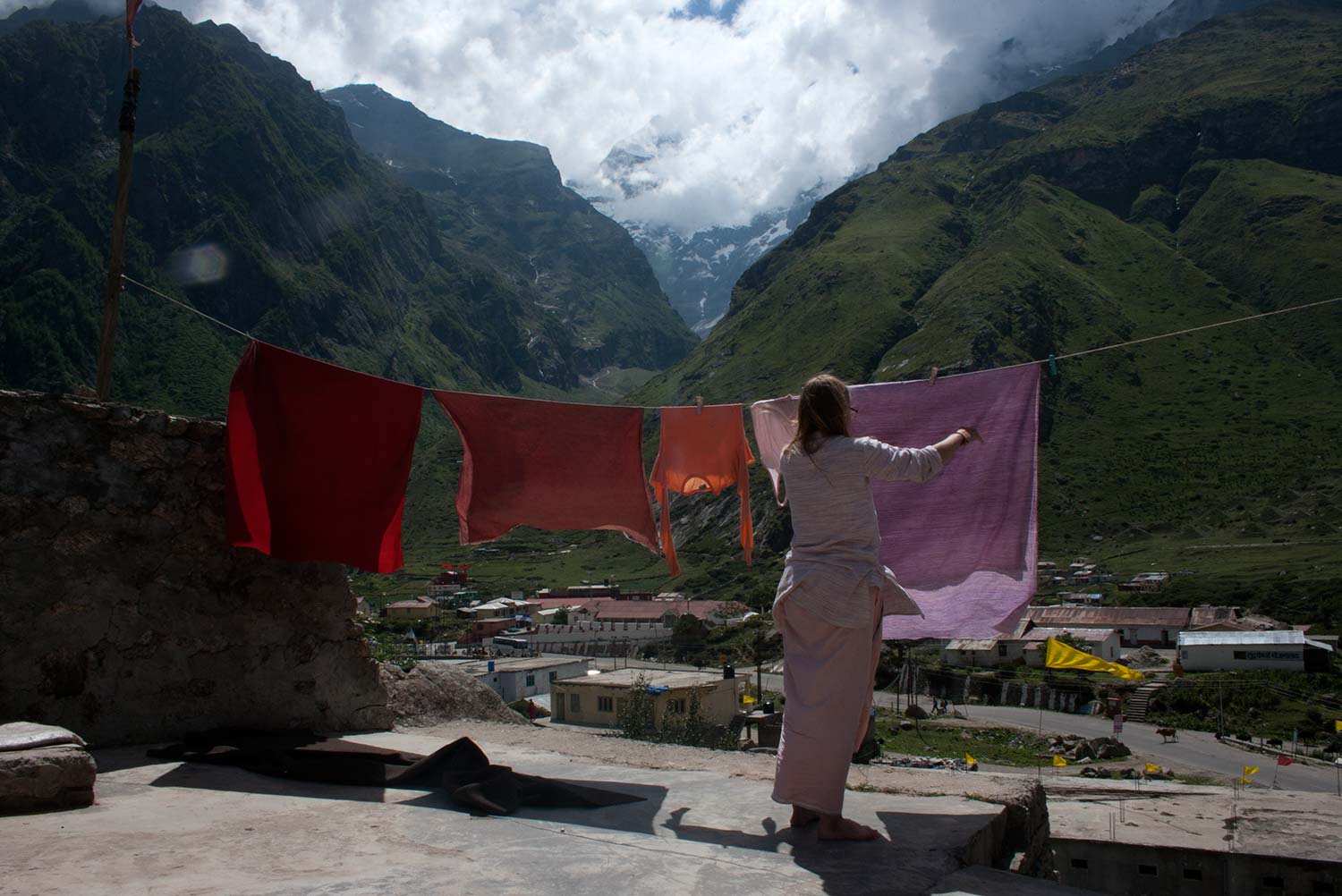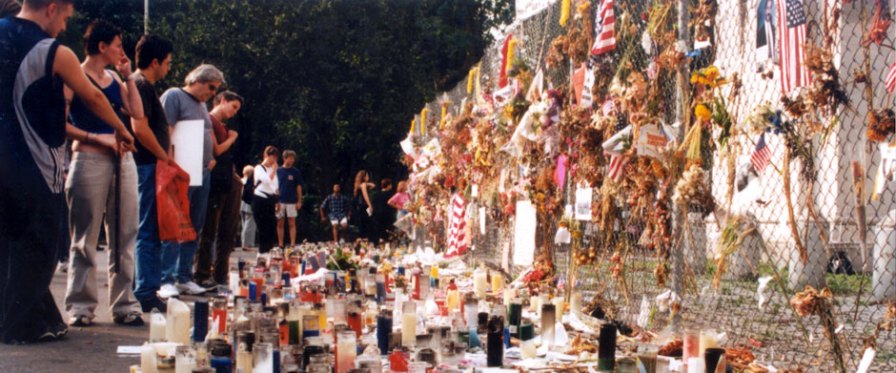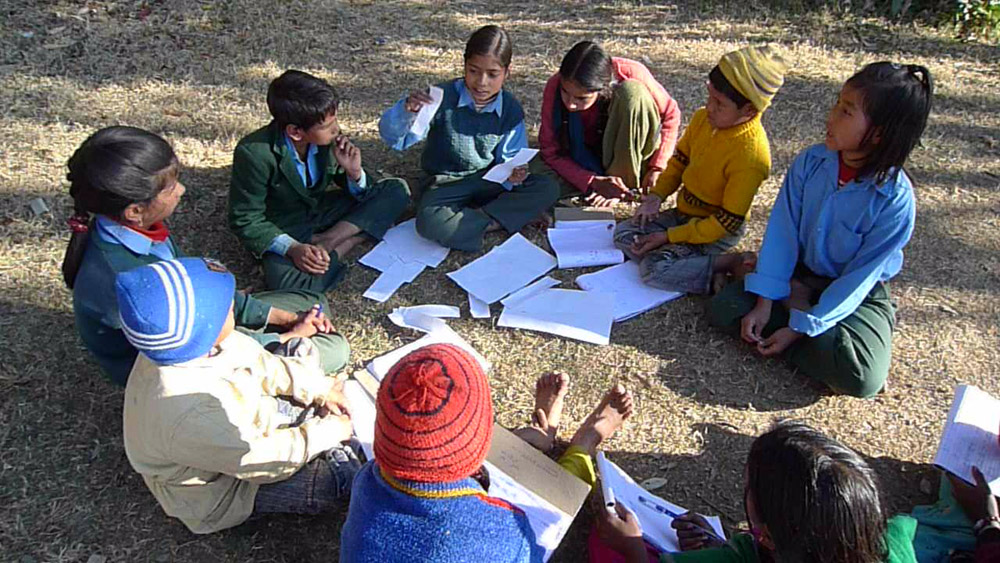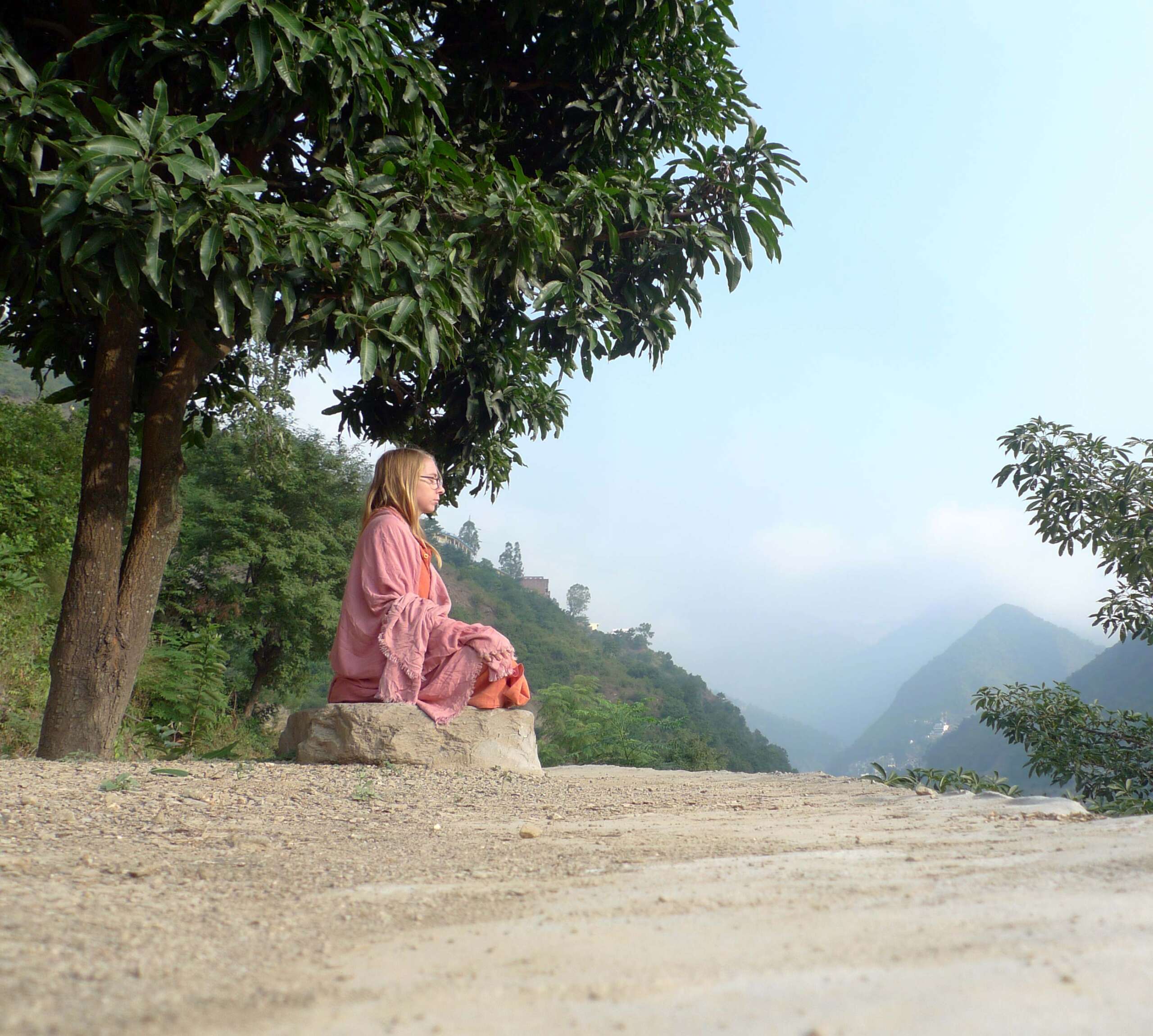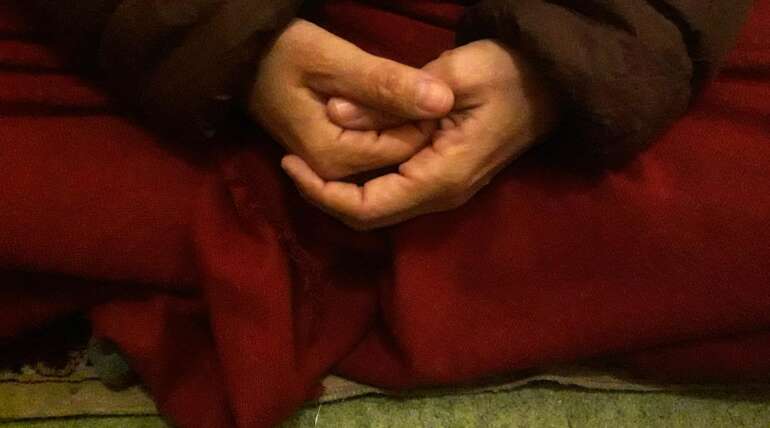As a wanderer… Our names have been changed so many times we begin to cling to our original crumbling identity even more, our ears now buzzing with mantras lost in translation.
 Back in Summer 2013, I was visiting a good friend of mine in Chandigarh, who I know from the Kumbh Melas. He’s a generation between my parents’ and mine and in that sense I look up to him somewhat like a mentor, whose advice is worth considering. At the time of this few day meeting, I was shooting interviews of him to use as voice over for a video he wanted me to make about his guru Godavari Giri (who took mahasamadhi in 2010), a video that would loop on a large LCD monitor in the samadhi mandir he was having built at the ashram where he left his body in Nahan, Himachal Pradesh. So naturally our conversations both on and off camera were on the topics of guru / shishya relationships, ashirvad, divine timing and of course my own wandering.
Back in Summer 2013, I was visiting a good friend of mine in Chandigarh, who I know from the Kumbh Melas. He’s a generation between my parents’ and mine and in that sense I look up to him somewhat like a mentor, whose advice is worth considering. At the time of this few day meeting, I was shooting interviews of him to use as voice over for a video he wanted me to make about his guru Godavari Giri (who took mahasamadhi in 2010), a video that would loop on a large LCD monitor in the samadhi mandir he was having built at the ashram where he left his body in Nahan, Himachal Pradesh. So naturally our conversations both on and off camera were on the topics of guru / shishya relationships, ashirvad, divine timing and of course my own wandering.
Towards the end of our three days together, before he dropped me off at the train station, we were having a chai in a hipster Chandigarh café, where he said to me “Nimi,” – he called me Nimi as a play on my being a twin and not certain how many times my sister, Michele and I may have gotten mixed up as babies – “I have to tell you something before you go. You may not understand what I’m talking about right now, but all in good time, you will.”
Of course I was curious, from the seriousness in his voice this sounded like something big, life changing perhaps. Over the years I’ve known Neeraj I could clearly see that one of the many blessings he got from his guru was that of having a fine tuned intuition. I took another sip of chai, as he passed me an already lit cigarette, (he always encouraged me to smoke with him, as he never felt comfortable smoking in front of his own wife and enjoyed the freedom he felt to be himself with me) and he continued, “Nimi, it’s difficult for me to watch you waste all this time and effort trying to get yourself to Bombay, when I know eventually you will find yourself suddenly in China and come to the realization that you should have been trying to get to China all along. But by that time it may be too late indeed.”
I understood this as a metaphor, (obviously I’ve not been trying to literally get to Bombay), but honestly at the time I didn’t see it all as clearly as I do these days. This much however I did understand, he was referring to my wandering. Wandering India all those years (since 2000-2001 Kumbh Mela I’ve been coming here), collecting footage for a film I’ve yet to bring myself to edit, wasting time with this ascetics with cameras project as a way to get closer to the Akhara, collecting photographs and videos for some very important archive, sort of (but not consistently) doing some study and some sadhana, meanwhile volunteering in alternative schools to legitimize my being in India this long and even more foolishly searching (with my eyes closed to what is right in front of me) for a guru.
I got on the train back to Haridwar, ordered another chai and fruitlessly pondered the metaphors of our conversation, wondering: What is this “Bombay”? Ok maybe Bombay I understood; but what is this “China”?
 You see, for more than a decade I’ve been “making a film” about female sanyasis, with this illusionary vision of potential characters, I built on false assumptions of what I thought a guru was, what their role would be, how we would relate to each other, what and how they may teach me. I mistakenly screwed my American Feminist cultural conditioning filter onto my lens, through which I could only fail to see this world as it IS. Eyes wide shut blind, narrow mindedly in search of independent, confident, outspoken, leader, female gurus, among Indian women, culturally conditioned in pre-feminist patriarchy, mostly chelis to their male gurus, many having narrowly escaped abusive husbands or fathers, only to repeat the eternal recurrence of the same situation of their obedient subservience, or even worse, reversing the abuse on to their own female chelis. These were not the film characters I was hoping to find, much less have as among my own five gurus; my ego still too big to silence my “why?” questions, much less my confident opinions, in certain male company as normally would be expected, forget considering doing the laundry, cooking or cleaning for some lazy seeming man or woman for that matter (in this case, an unfortunate DIY – do it yourself – lesson the circumstances of my single mother taught me: “you don’t have to for them; but do for yourself.” – and thus a huge obstacle in my preparation to become anyone’s shishya). There were still so many things to which I had yet to open myself, in order to be able to understand the subtle nuances involved in the guru/shishya parampara (traditions) of this esoteric world of eternal truth. I was a wanderer and a stubborn one at that.
You see, for more than a decade I’ve been “making a film” about female sanyasis, with this illusionary vision of potential characters, I built on false assumptions of what I thought a guru was, what their role would be, how we would relate to each other, what and how they may teach me. I mistakenly screwed my American Feminist cultural conditioning filter onto my lens, through which I could only fail to see this world as it IS. Eyes wide shut blind, narrow mindedly in search of independent, confident, outspoken, leader, female gurus, among Indian women, culturally conditioned in pre-feminist patriarchy, mostly chelis to their male gurus, many having narrowly escaped abusive husbands or fathers, only to repeat the eternal recurrence of the same situation of their obedient subservience, or even worse, reversing the abuse on to their own female chelis. These were not the film characters I was hoping to find, much less have as among my own five gurus; my ego still too big to silence my “why?” questions, much less my confident opinions, in certain male company as normally would be expected, forget considering doing the laundry, cooking or cleaning for some lazy seeming man or woman for that matter (in this case, an unfortunate DIY – do it yourself – lesson the circumstances of my single mother taught me: “you don’t have to for them; but do for yourself.” – and thus a huge obstacle in my preparation to become anyone’s shishya). There were still so many things to which I had yet to open myself, in order to be able to understand the subtle nuances involved in the guru/shishya parampara (traditions) of this esoteric world of eternal truth. I was a wanderer and a stubborn one at that.
In 2004 Ujjain, now my third time to India and in between video mixing for parties throughout Delhi, Bombay and Goa, enjoying the nightlife not unlike what I was used to in NYC or The Playa (ie. Burning Man), this was the first year I was invited to shoot video of the women’s initiation rites. In a tent full of freshly-shaven solah madi mata jis (about to become sanyasi women among the 16 lineages of Puri families) waiting for their rebirthing to begin, I met Naravada Puri Mata Ji, the first foreign woman to be allowed to take this final sanskar in order to officially join Juna Akhara. However much we did not get to talk during that 24 hour ordeal, I was impressed by her seriousness and the way she did not let the camera distract her from her focus, like many of the other Indian and Nepali Mata Jis. There was an attraction I felt towards her, like a magnet and throughout the mela, another sadhu naga baba elder brother friend of mine kept telling me to go to Haridwar to meet her and stop wasting my time with these Indian Mata Jis, assuring me, she’s the real thing, “go become her disciple!” he instructed. However months later when I did find myself in Haridwar, after a quick snaan at Harki Pauri, the rural outskirts reputation of Haripur Kalan off the main road towards Rishikesh seemed daunting (without a proper name or address of the ashram) so I continued on wandering towards the comfort zone of the cafes and swimming spots of Laxman Jhula among the other English speaking wanderers (my Hindi still at a basic level back then).
We met again in 2007 Kumbh Mela, in brief passing as I continued to wander among the tight alley ways of the Juna Akhara camps, om namo narayan-ing to each other with nods of recognition. But my lack of focus and easily distracted senses led me in various directions.
As a wanderer…
However much we may be stumbling through learning little bits here and there, we are indeed not serious enough, not stable enough, not focused enough, most of the time not even fully cognizant of the actual goal and thus not all at ready to be anyone’s official shishya (disciple student).
We carry ourselves as if we know the way already, like a stubborn American man driving in circles yet too proud to admit he is lost much less actually ask for directions.
Our shelves are filled with books we’ve studied, or pretend we have (secretly planning to later, someday), filled with little space left for any more topics from opposing perspectives.
We have enough luggage with us to require a kooli at each station, both material and emotional, and foolishly collect more unnecessary stuff along each yatra, making sure to possess all the paraphernalia in order to play the role of what we think one should look like to be on this path.
And for the countless satsangs we’ve been blessed to have been in attendance, our pot is already so full of what we think we know already, that everything that could be poured inside just overflows spilling out in dribbles that mark our wandering journeys like breadcrumbs left behind our footprints in the sand.
In the cafes, (beaches, trails, markets and ghats) of Rishikesh (Goa, Manali, Pushkar, Benares), we compare notes with other wandering foreigners, dropping sometimes poorly pronounced Sanskrit words to describe our false awakenings, experiences mostly had stoned on charas or psychedelics, having not yet experienced actual meditation.
And however much, we may look good sitting in apparent “silence”, if only they could hear the conversations buzzing inside our heads.
We hold our balances and twists long enough to pose well for photos; yet allow our unbalanced minds to become disturbed at the slightest twist obstructing our path.
And on which ever path we are traveling, we can just as easily change directions, enticed by a good looking fellow wanderer seen in the distance and allow ourselves to get lost on a temporary detour with them, only later to have to backtrack in order to continue from where we left off.
We have had many seeds planted in us, having collected several panch mukhi rudkrash “gifts” dangling on sacred white strings, yet we have too many rocks in our garden and the soil is far too contaminated for any of these seeds to have the proper conditions for which to spout.
Our names have been changed so many times we begin to cling to our original crumbling identity even more, our ears now buzzing with mantras lost in translation.
And although we are unaware of the weight of the significance of it all, much less how this will germinate and affect us more than a decade later, we return to our countries with elaborate stories and exotic photographs, and a subtle inner glow however much undetectable to the distorted and dusty mirror of our self, quite recognizable to much envy of our nine-to-fiver friends.
 We travel back and forth, transcending time zones more than duality, without even the basic gyan to register ourselves for frequent flyer miles… East, West, East, West, East, West, East, West, East… swinging our lives back and forth like a pendulum, every few years according to the Kumbh Mela titis, changing our wardrobe appropriately, wasting our efforts, trying to stabilize our left and right feet on two boats going in opposite directions, till the point of exhaustion. Till finally once and for all, we fall crashing deep into the ocean that is the vast distance between these two opposing (material / spiritual) worlds.
We travel back and forth, transcending time zones more than duality, without even the basic gyan to register ourselves for frequent flyer miles… East, West, East, West, East, West, East, West, East… swinging our lives back and forth like a pendulum, every few years according to the Kumbh Mela titis, changing our wardrobe appropriately, wasting our efforts, trying to stabilize our left and right feet on two boats going in opposite directions, till the point of exhaustion. Till finally once and for all, we fall crashing deep into the ocean that is the vast distance between these two opposing (material / spiritual) worlds.
It is then, that we ultimately let go. We surrender. And we realize, that it is by swimming to the depth of our own ocean that we find inner calmness. Those who struggle among the waves to stay afloat at the surface only perpetuate their struggle by being the very cause of their ocean’s turbulence.
 But in the beginning, the depths of our own ocean is not a suitable permanent residence for us, rather we are not suitable to reside there. We can visit (this state of mind / deep ocean), but we are still too impure to survive on this prana alone; addicted to our inhalations, we keep pulling ourselves up to the surface again to gasp for air, only to be smacked in the face by another wave of material life. But we’ve tasted it, and that taste still lingers in our consciousness and we know there is something more out there (rather shall I say, deep within there) and we want to return. So we practice. We make effort to clean ourselves, to eliminate the waste of weighty (material/emotional) luggage. We put ourselves in more uncomfortable situations, challenging the way we thought we knew everything to be. We surround ourselves with others committed to this path, to get inspiration, encouragement and support. We learn by each other’s example to exhale more, metaphorically shedding all the things to which we previously clung, clean out our closets so to speak, purge our memory created images of how we think things are and will or should be again, striping away our cultural conditioned lenses that have been obstructing our innate correct vision of the truth.
But in the beginning, the depths of our own ocean is not a suitable permanent residence for us, rather we are not suitable to reside there. We can visit (this state of mind / deep ocean), but we are still too impure to survive on this prana alone; addicted to our inhalations, we keep pulling ourselves up to the surface again to gasp for air, only to be smacked in the face by another wave of material life. But we’ve tasted it, and that taste still lingers in our consciousness and we know there is something more out there (rather shall I say, deep within there) and we want to return. So we practice. We make effort to clean ourselves, to eliminate the waste of weighty (material/emotional) luggage. We put ourselves in more uncomfortable situations, challenging the way we thought we knew everything to be. We surround ourselves with others committed to this path, to get inspiration, encouragement and support. We learn by each other’s example to exhale more, metaphorically shedding all the things to which we previously clung, clean out our closets so to speak, purge our memory created images of how we think things are and will or should be again, striping away our cultural conditioned lenses that have been obstructing our innate correct vision of the truth.
Then we go extreme. We quit our respectable jobs, we buy a one way ticket and hope our money lasts. We exhale… aaaauuuummmmmmm

In 2010 Haridwar Kumbh Mela, I finally met her a third time, now in a crowded tent in the women’s camp nicknamed “Mai Varda” where I was once again invited by the same Mata Ji as that first time in 2004, to make a video of the panch guru sanskar of several of her new chelis (five guru initiation rites into sanyas, where one enters the stage of maha parush). Everybody who was anybody, among important women, was there. And after the ceremonies were over Narvada Puri and I caught eyes from across the sea of orange among that tent and began to make our way to finally meet in the center. With an acknowledgement of recognizing each other mela after mela, yet in a scene too hectic to get involved in any serious conversation, we quickly exchanged phone numbers and I made a commitment to visit her ashram.
I visited, several times; it was beautiful. She was usually vague and soft-spoken, perhaps speaking things I was not ready (pure enough) to hear clearly. I even had foreign friends I knew staying there. But I was still a wanderer and yet so much I wanted to be different from all the other wanderers I assumed all those other foreigners to be. I was a wanderer on a serious pendulum trip. I needed the extreme opposite: “I didn’t come all the way from NYC to India to hang out with a bunch of foreigners” this time also avoiding my previous comfort zone of Rishikesh, (like Haridwar was the Brooklyn to my Rishikesh Manhattan). So I allowed my inner snob to lead my ego, thinking I needed to be in “Bombay” where all the Indians were. And like any arrogant American who thinks they already know what is best for them, I stubbornly turned down her offer to live at Santosh Puri Ashram, foolishly thinking, “she can’t possibly be my guru, she’s white like me”.
And I was a wanderer, on a pendulum – sure now this pendulum got shortened, no longer needing to cross oceans, but still swinging nonetheless – swinging between living in ashrams with both male and female sanyasis; staying in caves at pilgrimage places; living in ashrams with meditating / collaborating teachers where we co-ran a school of over 100 students (KG-8th) – where I was taught that yoga can also be mindfully walking in the forest or chopping wood, anything I do could be a yoga, so long as I maintained a constant awareness of my breath.
And I was a wanderer, on a pendulum… swinging between living among 23 people – ages 7-37 in a modest house, nestled just 40km below pre-flooded Kedarnath – where we meditated, farmed, composted, cooked, swam, hiked, made music, sang, danced, painted, drew and ran a holistic education experiment (ie. alternative home-school) together – where I was taught (alongside the most incredibly wise children) by a female embodied maharaj in plane clothes, to “look at myself, listen to myself, and truly understand myself”. It was there that I was reminded, you did not need to join an organization or wear their uniform in order to do sadhana and began to clean my inner mirror, cultivate my own witness. And with all this constant self-observation, I was forced to face my American-ness, much of which (as seen in the mirror of them) I was eager to shed. Only to find myself once again setting up an international camp at the 2013 Kumbh Mela in Allahabad, playing host to a bunch of other wanderers.
And I was a wanderer, on a pendulum… now slightly getting over this “I’m too cool to hang out with foreigners” trip, and began swinging my pendulum back to Rishikesh to check out the crowded post gentrified, capitalist yoga scene there. Having learned a few things about Iyengar alignment, then full on back swing to Haridwar again, to do seva in another Juna Akhara ashram (my official address) where I was the only woman and only foreigner – where I learned to get over my feminist ego, serving elder sadhus (most of the time reminding me of my father who left my mother and us to do it all on our own anyway), and a newly initiated swami, with a growing ego of his own having quickly climbed the ladder to thanapati, yet almost young enough to begin playing the role of my son. I learned the art and felt the compassion of Indian hospitality through serving them and our on going stream of householder guests. Then I swung the pendulum again, to spend a month doing seva at a Vipassana Center guiding foreigners through their first major inner journey; and then another few weeks (at both Swami Rama’s hospital near Jolly Grant as well as his Sadhak Gram Ashram) taking care of a neurotic borderline OCD, American Mata Ji while she got a pin removed from a previous hip surgery. Then one more swing of the pendulum to finish off 2013, wandering around with my twin sister and her husband, playing tour guide to two people who actually had no interest in India much less its spiritual culture in which I was diving so deep – all the while intensely facing myself in their mirrors.
And however amazing all of this had been, honestly I was dizzy and tired of wandering. I wanted to get on with it already, start my next chapter of higher (spiritual) education.
And I remembered in those three years, in between each swing of my pendulum, the stability of the middle point was felt in visiting Narvada Puri Mata Ji. Somehow always sharing all the right answers and advice to all the questions I was too shy to ask, even to the questions that had yet to break the surface of my subconscious mind. Filling me with the confidence that everything I was doing was ok, encouraging me to keep doing seva in all the ways I was, encouraging me to dig even deeper into the culture by continuing to immerse myself in Garhwali village life, like I was. Reminding me, I was on the right path and giving me (through her blessings each time we met) the strength to keep walking.
In my last visit with her in mid-January 2014, before she left her body in Mahasamadhi, after our usual pattern of chai, catch up on local current news, and silence… she began her satsang with me, “Sure there are plenty of places you can go for higher education, Nicole” listing all the places (I had not told her) I’d been considering the past few months: One Mata Ji in Uttarkashi – cheli of Dayananda Saraswati, Sivananda Ashram, Swami Rama’s Ashram, even the University down the road. She continued, “also keep in mind, you could do it how we have done it and just live here, Nicole”. But I was busy not listening to her advice and preparing to take two more swings on the pendulum (having already booked a train to Delhi that night): to stay with one of my (Indian Mata Ji) gurus in Gurgaon, as well as later visit a family (I’ve know since that first trip in 2000-2001) for the last month of Magh Mela in Allahabad. Then she made a second comment that still rings in my ears. “You know Nicole, the funny thing about Americans is that they seem to think they have to do everything on their own.”
I had nothing I could say to that, because yeah, she was right. And for months this comment haunted me, so much so, that I often questioned, how do I reconcile this?
 Then when circumstances beyond my imagination brought me another invitation to live at Santosh Puri Ashram, a handful of months later as my pendulum was beginning to settle its swing once and for all, ultimately I realized, that was it: the quintessential reconciliation of my circumstantially culturally conditioned DIY attitude, was to help someone else (her three children in this case), so that they didn’t have to do it all on their own (like I did).
Then when circumstances beyond my imagination brought me another invitation to live at Santosh Puri Ashram, a handful of months later as my pendulum was beginning to settle its swing once and for all, ultimately I realized, that was it: the quintessential reconciliation of my circumstantially culturally conditioned DIY attitude, was to help someone else (her three children in this case), so that they didn’t have to do it all on their own (like I did).
And however I had been taught to perform omkar nearly ten years before, it was something I rarely did, yet here to do so seemed quite naturally appropriate; it was within only a few days of performing my omkar to Mata Ji’s Samadhi, that it dawned on me, as if (the ghost of) she alone was holding up the sign “This Is the Way!” So when I finally looked up at the map in her hands, to find that big red dot that reads “You Are HERE” – I realize, there is no need to wander anymore, because to nearly pathetic irony, that big red dot was indeed hovering over “China”.
As I began to archive her lecture recordings, an initial sadness came over me sprinkled with guilt, that all though years living in Uttarakhand, wandering, searching for Bombay, I didn’t ever wander into her class. And as I heard the echo of Neeraj’s voice saying to me that prophetic afternoon in Chandigarh, “But by that time it may be too late indeed,” a deep sense of shame and regret came over me, that now that I actually found my way to China, now that I’m actually empty enough to be a shishya, she is no longer in the form, able to be my guru. So the best I can do is to allow her to shine through her children, who are still in their forms, and in the presence of them, I can bask in her light, hear her lessons through their stories and serve her, through helping them.
Ultimately there is no guilt, no regrets, and only acceptance that everything has its own divine timing, everything is going on correctly according to schedule, and understand that this wandering phase is one that we all must pass through. It is where we get our bumps and bruises, where we get the most challenging lessons, where we have to face ourselves in the mirrors of everyone who we encounter, where we can empty ourselves out, dropping luggage at every station. All this wandering acts as the working grounds on which we prepare ourselves to become a student.

I found out first hand in those last years of wandering, that it is in this commitment to doing karma yoga for a living, that we purify ourselves. We do things for free, things we would never have done for money in our own countries, things for which we’d consider ourselves way too over qualified. We do things for free, things that even utilize our skills, skills that we’ve spent enormous amounts of time, effort and money to cultivate, we do the things that we had previously earned a substantial income, and we do these things for free. And on top of all that we actually begin to drop our expectations of results, rewards and credit; we serve people for nothing other than their need of assistance and our ability to assist. And in utter opposition to the American Dream career chasing ladder we were set up to climb – we tear that ladder apart, crumble it along with our cultural conditioned identity, then use the wood from this ladder to burn up our unnecessary karmas and melt the ego that has been blocking the doorway to open our heart. And the more we do this, the more opportunities arise for further purification. And the easier it becomes to surrender to what IS. And sooner or later everything begins to flow, like for once in our lives our plan and the divine plan cease to be two, eliminating the struggle we used to feel with the hustle of keeping up with this all this wandering and finally one path begins to illuminate itself, outshining the other options that used to distract us and lead us astray. And on this path alone, we meet ourselves, new born, finally ready, empty enough to be a student, and the real journey begins.


